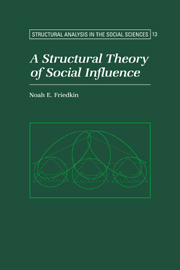4 - A Structural Parameterization
Published online by Cambridge University Press: 23 December 2009
Summary
Abstract. I describe a structural approach to the theory of social influence in which measures of actors' social positions and interpersonal influences are based on their network of interpersonal visibilities. Subsequent chapters in this section (Chapters 5–7) will elaborate and support the structural approach that is introduced here. In the present chapter, I also describe the survey data upon which my measures are based and certain elementary network concepts that will be useful later.
In this chapter I outline an approach to the theory of social influence in which measures of actors' social positions and interpersonal influences are derived from their network of interpersonal visibilities. Interpersonal visibility exists when an actor i has some information about another actor j. The information may concern actor j's opinion on a particular issue, j's violation of a proscription, j's performance of a prescribed activity, j's expertise and interests, or j's personal affairs and circumstances. Visibility of role performance has been of interest to sociologists since preliminary statements on the subject by Simmel (1950), who used the term “surveyable” to refer to the extent to which the role-performances of actors may be scrutinized. While Simmel was concerned with the ability of aristocrats to observe the behavior of other members of the aristocracy, Merton (1968) has generalized this concern to any social system. The classical interest in interpersonal visibility derives from its relationship to social control (Coser 1961; Skolnick and Woodworth 1967; Merton 1968; Warren 1968).
- Type
- Chapter
- Information
- A Structural Theory of Social Influence , pp. 53 - 67Publisher: Cambridge University PressPrint publication year: 1998

